This is part one of my extensive photographing Hawaii guide. Hawaii is an island formed from volcanoes and on “the big island” there is still an active erupting volcano. Now, warning, it’s lava people, it will kill you. DO NOT attempt to approach the lava fields without getting trained and utilizing the experience of professionals. Lava can be safe if you follow the rules, but if you just start walking out in the field you can easily find yourself trapped with no way out and praying for a helicopter to fly overhead!
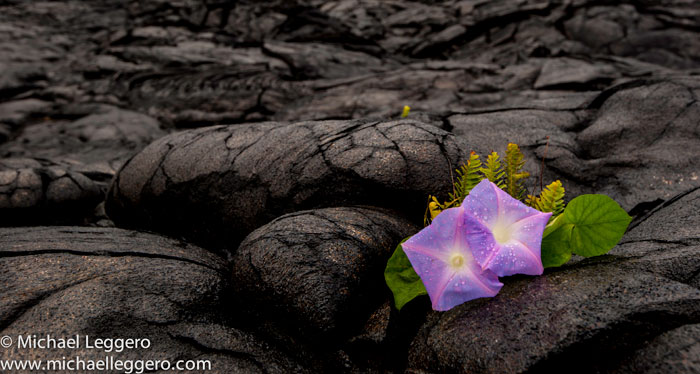
PS – This article continues on from my part 1 of photographing Hawaii
Viewing lava in Hawaii is possible for everyone. It’s just a matter of how you want to experience the adventure that differs from photographer to photographer. Most people will never see the red hot lava pouring out of the ground and flying up in the air, but with the proper guides, you too can explore them on an up-close and personal level.
Photographing lava and seeing it in all its splendor is best done at dawn or dusk. After talking with locals, I decided that dusk would be the best option, so I wouldn’t have to walk back in the brutal heat of mid-day.
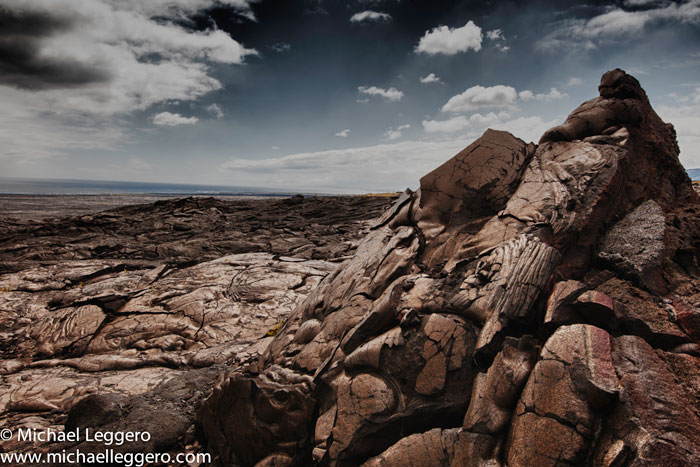
After numerous phone planning conversations, I met with my guide at the starting point of my journey. There were only three of us – myself, my guide and one young energetic man in his early 20’s who had been hiking out there many times. I knew I was in for an adventure when I had all the recommended gear, footwear and hiking poles, and the guide was wearing shorts and a tee shirt and flip flops on his feet!
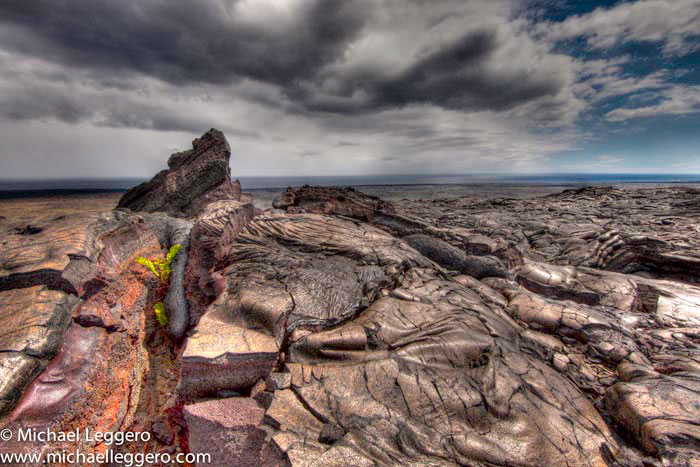
We were on our way to the Kilauea Volcano lava flow. To get to active lava flows, the red hot glowing lava, you have to cross old lava flows. Now, old lava flows are some of the worst walking environments that I’ve ever experienced. It is dark colored and shiny – perfect condition to reflect the sun and its heat.
Every time you step it crumbles away from your weight and heaven help anyone that falls, because it is razor sharp and will tear your skin apart. We have 3 miles of this evil terrain to walk through and that’s not 3 flat miles.
It’s up and down hills and valleys and jumping over crevasses! Then all of a sudden the ground becomes hot beneath my feet and I look down to see the soles of my shoes smoking and melting a bit. We have arrived! “Oh yeah Mike, make sure you don’t stand in one place – keep your feet moving,” the guide says once we are there.
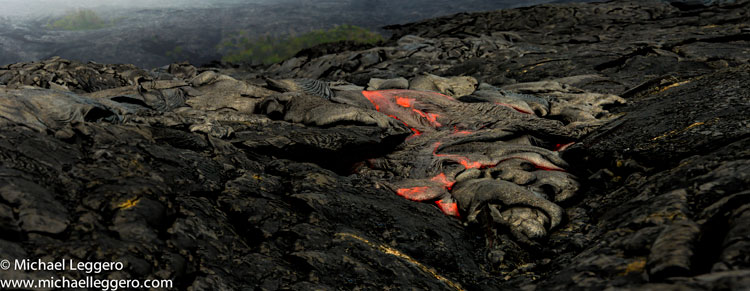
The walk through hell was definitely worth it! Once you see the lava in person, you forget about the real world and your imaginative mind takes over. This is rock, and it’s moving and flowing and expanding right in front of your eyes!
It’s beautiful and in the back of your mind you realize this is the most destructive thing you can imagine. Caution immediately sets in as reality comes back. It’s not like Antarctica where if you get wet and step through the ice submerging your foot, you’ll just dry off later. Here, if you step through the thin crust and fall into the lava, you die! I can’t stress enough the importance of having a guide if you are not VERY EXPERIENCED.
Techniques to photograph lava are definitely unique, just like everything else we photograph. Lava moves, sometimes slowly, sometimes fast. A tripod can be helpful to support the camera, but more often than not, I found myself working handheld.
Long lenses are your friend. You don’t want to be up at the edge of the flow for more than a couple seconds with a wide angle or you risk coming back, like me, with all your leg hair singed off.
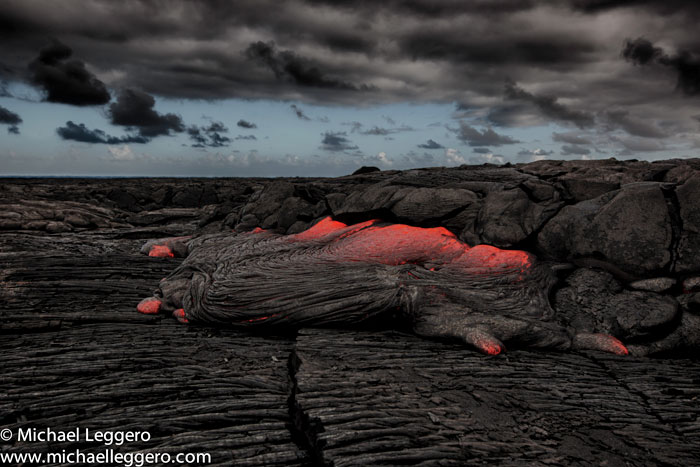
The basic rule is to get completely prepared for the shot, plan it in your head, move up to the edge of the flow, take a few pictures in about 3-5 seconds, and then back away from the 2000 degree furnace. You’ll find yourself doing this over and over and over again!
Batteries are also going to die fast. Your camera does not like being that hot and most batteries give out quickly. Do not carry them in your pockets. Find a safe place and leave all of your gear back away from the heat and the danger. And keep in mind that black backpacks and camera bags are difficult to find at night against the black ground, so leave a spare lit flashlight sitting on top of your bags.
Since it is dusk, having a tripod is still a big help. You can get amazing images of glowing red lava and have all the colors of sunset in the background. Just be careful where you place your tripod, because the feet of a tripod are very tiny and can break through the fragile crust easily. And again, you’ll need to work rather quickly or you and your equipment will get really hot!
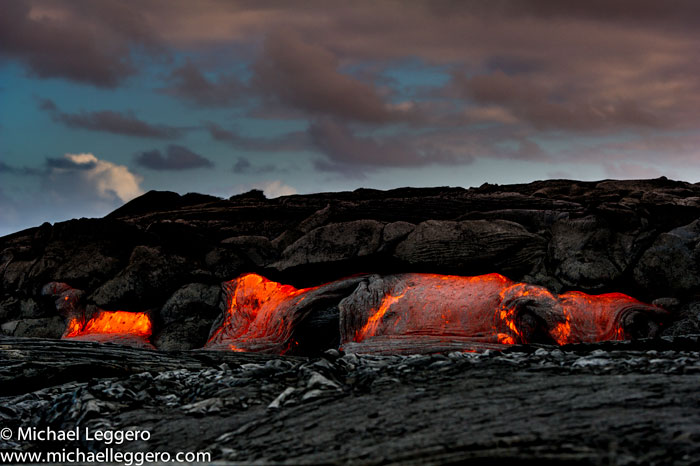
Shutter speeds can range from fast to slow depending on the effect you want to achieve. You will have to experiment, because the photographic outcome of a flowing lava field image will look totally different from a flowing water image.
One bonus of a slow shutter speed is that if the lava is just red and glowing and then suddenly in the middle of your exposure it explodes, then you will have an awesome trail of sparks. Unfortunately, or is it fortunately, I didn’t get to experience an explosion! Play around and plan to be there for some time. And remember, batteries burn out fast, so using a remote shutter release is out of the question.
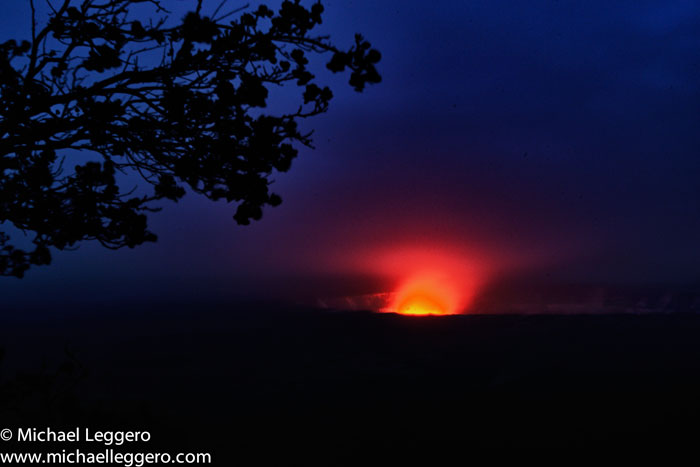
Lava after dark really comes alive. It’s also when it’s the most dangerous, since your visibility is gone. Nighttime photography is a challenge even with normal conditions, but when the conditions become life threatening, it might be time to remember, it’s only a picture! Time to go!
That being said, it’s now dark and the main guide left an hour ago (agreed upon at the start of the tour). It’s now only me and a testosterone filled adventure kid and he is off somewhere exploring another flow. I’m fine with that. I have a GPS, so I can find my way back. I figured it would be no problem – there I go with figuring and thinking again! “I gotta stop doing that!”
Remember the razor sharp rocks on the way there? Well, they are worse on the way back, because even with a flashlight on my head, I can still only see a few feet ahead. In daylight you can see the terrain’s obstacles, but at night, there is no more planning. You just walk along and, “Oh no, where did this wall come from?!?”

To make matters worse, I had slipped and sliced my hand open just 10 minutes into the hike. Now I’ve got one bleeding hand and the other hand holding the wound, which works fine, but I’m now short a third hand to hold the GPS.
I do know if I keep the lava behind my left shoulder I should be going in somewhat the right direction. After about 4 hours of walking, Mr. Young Adventure catches up and goes into some babbling of how the hiking in the lava fields is the best part of the venture. Nope! Not fun! Not the best part! Maybe when I was younger, but not now, not in my non-youth!
We are walking along and I know we are about a mile from the end when all of a sudden, 200 feet away, I see headlights! That’s a road! The kid, in his youthful, inexperienced brain says, “We can’t walk on that! It’s a private road! We can get arrested!” I figure what’s the worst that can happen. I get picked up by the Hawaiian police, get thrown in the back of a car and driven to a bed! Double bonus!
So I take the detour to the road and I’m back at our starting point in about 10 minutes. About 2 hours later Mr. Young Adventure makes it back. My idea was better and I stand by it! I slept on the guide’s couch and woke up to start another day’s exploitations.
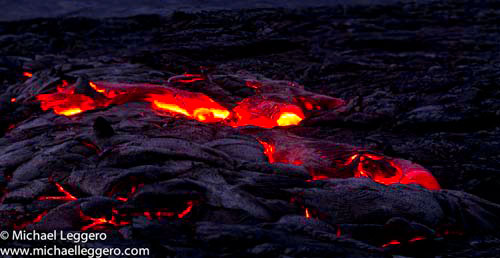
Note: Be careful when choosing your guide. You need to determine and know your adventure level and choose accordingly. Do you need someone with you at all times or are you able to venture out some on your own?
Whether it’s venturing to the jungles and waterfalls or the lava fields, I’ve learned a few things about how to make my next trip to Hawaii more enjoyable.
To help you avoid all the mistakes I made…
1. Rent a jeep – don’t get a car. A jeep will get you to more out-of-the-way places faster and safer.
2. Know if you can drive to get closer to your destination. Of course you can walk to anywhere, but it may take you 2 hours of a light easy hike or 3 hours of a deadly exhausting trek that could have been driven in minutes. And remember, you also have to walk back! Unfortunately the only way to get to the lava fields is by foot – grumble, grumble!
3. Plan your hiking adventures with plenty of time to spare.
4. When you aren’t near a big town make sure you eat early. In the small towns places close early. In Hilo for instance, the world shuts down on Sunday – nothing is open anywhere.
I have been to many islands and many different countries. I thought it would be similar to the feeling of going to any other island for a week. When I came back to “the real world”, I realized that even though I was in the United States, the entire visit felt different.
Hawaiians live by their own culture and have a unique way of life. As I look back on the trip, I thought I was done with the island. I figured O.K.; I’ve seen it, what’s next on my list? But as the locals said, the island will call me back. They are right. Something about it just makes it magical and opens the imagination to return.
by Michael Leggero
All text and photos: © 2012 Michael Leggero. All Rights Reserved.

Leave a Reply